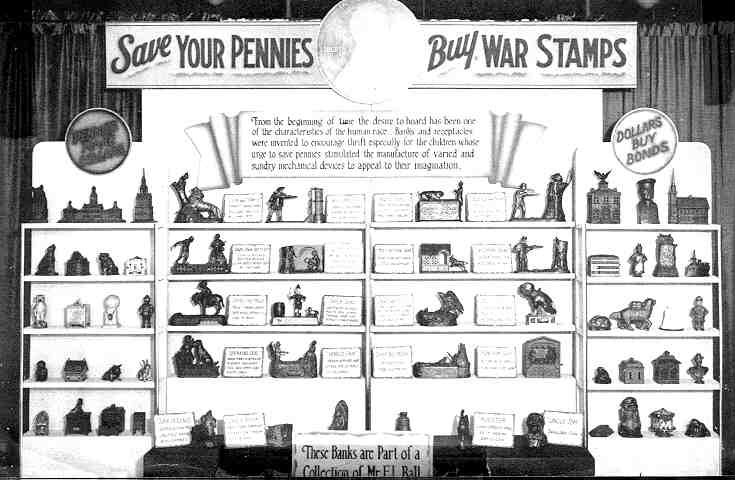Penny Banks
PROMOTE WAR BOND SALES AT MALDEN
By Francis L. Ball CONTACT, March, 1944
President, Maldem Electric Company

WHEN planning a window display to aid in the promotion of the Forth War Loan drive at Malden, the idea was conceived of building it around an exhibit of part of my personal collection of old penny banks — picturesque symbols of thrift. How these old banks, the modern Lincoln penny, the promotion of savings and the purchase of bonds were combined in this display is best explained in the illustration herewith. The interest inspired by the display among both employees and the public has led to a number of questions being asked concerning my collection and the history of penny banks, which I have tried to answer briefly in this article.
Thrift may not come under the head of a "hobby," but it is often referred to as an early American virtue. Encouragement was given the child in earlier days to save his pennies. For this purpose, toys in the form of banks were developed with the definite purpose of luring the young into the habit of saving. Here in America, the first banks for youngsters made their appearance before the year 1800 when the large copper pennies were in use. These banks were home-made from wood, clay and even gourds. Later tin banks were made, often in very crude form, these to be followed by banks made of glass in all kinds, shapes and sizes. Many of these glass banks served a dual purpose, the original function being for use as a container of foods, such as, a mustard pot in the form of a house, or possibly a beehive filled with honey which, after being emptied, could be used as a bank.
It was not until about 1869 that cast iron began to be popular in the manufacture of toy banks and ingenious craftsmen started designing figures which moved and performed feats, often reflecting historical and popular events of the day, Humor characterized many of them and even the spirit of satire was sometimes used. Sports furnished a wide field for imaginations of the inventors and makers of these toys, and the circus with its clowns and trapeze performers furnished the motif. Practically all of these mechanical banks were patented by individuals and in most cases the patent rights were sold to manufacturers who turned them out in quantity. It is interesting to note that the first patent was taken out by one J. Hall of Watertown, Mass., and among the foremost in their manufacture were the J. E. Stevens Company of Cromwell, Conn., and the Kingsbury Manufacturing Company of Keene, N. H.
Penny banks may properly be divided into two classes — "mechanical" and "still." Mechanical banks, as the name implies, are ones which have moving parts and some degree of mechanical movement. "Stills" are banks with no moving parts and are simply repositories for coins.
As an example of the ingenious mechanism of some of these mechanical banks, let us take the "Darktown Battery." Here can be seen the expression of triumph on the pitcher’s face as the batter at the plate misses and the ball (coin) is safely caught by the catcher behind the plate. Each of the three participants in this baseball game performs his part perfectly and in unison. Here is a bank that will amuse young and old alike.
An interesting example of still banks is the "Caricature Bank of General Butler, 1884." Here we find a ghastly caricature portraying the worthy Benjamin F. Butler in the guise of a bullfrog, carrying a huge wallet of paper money. Originally a staunch Democrat, he was most unpopular in the North because he supported John C. Breckenridge as a presidential nominee in 1860. During the Civil War, he aroused violent animosity in the South by the severe military administration which he instituted in New Orleans following the city’s surrender to the Union forces. In 1884 he ran for the presidency as a candidate for the Greenback (paper currency) and Anti-Monopolistic Parties and was dismally defeated.
As a result of these associated facts, the collector of mechanical banks finds himself
engaged in a pastime to which he can devote any amount of time, effort and study he may
desire, and one which is endless in its interest and entertainment. Personally, I have
found it to be one of the most fascinating and intriguing ventures on which I have ever
embarked.
